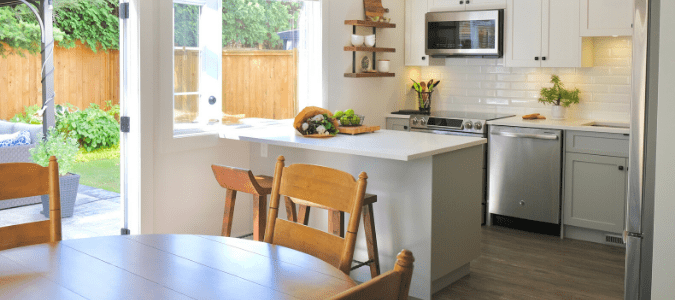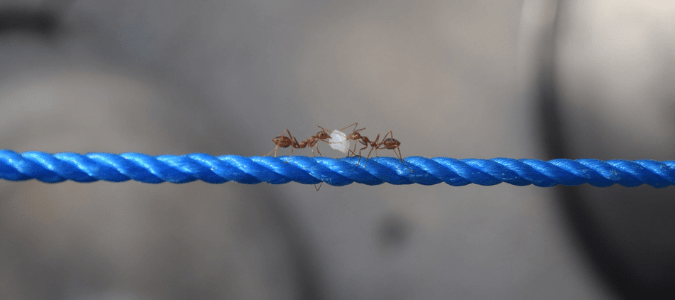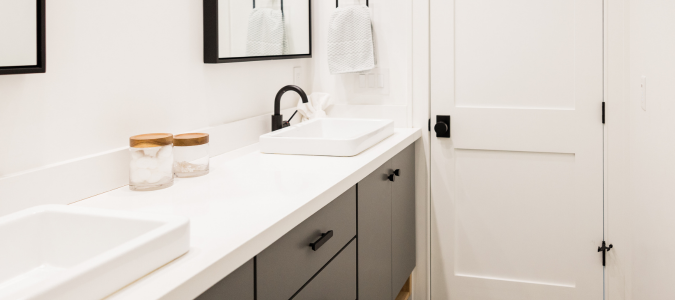An indoor ant infestation is a nuisance for many homeowners. While the ants themselves may seem harmless, they can reproduce rapidly and become a big problem, especially in the kitchen. There are several ways that homeowners can deter and get rid of ants in the house.
It’s important for homeowners to understand every part of the ant life cycle to control an infestation. It’s not enough to get rid of adult ants; you must control them at every life stage.
Another place where it’s common to find ants is in your bathroom. They love the moisture of bathrooms and have easy access to food and water. There are a few ways to reduce the number of ants in your bathroom on your own, but working with a professional pest control service is the best way to kick ants out of your home.
How To Get Rid of Ants in the House
One of the last things homeowners want to deal with is an ant problem. An annoying ant infestation can quickly take over the kitchen, bathroom and other areas of the house. Luckily, several at-home solutions can help control ants in the house. Remember that these methods are most effective when coupled with professional pest control services.
First, identify where the ant infestation is coming from. Ants are often attracted to a food source, so it’s likely that some left-behind food drew them into your home. Follow the trail until you find the source and clean it up.
The ants may go away on their own or try to find another food source. Once you have a few ants inside your home, more will follow. There may even be a hidden nest where the full colony is residing.
To stop the ants from attracting more ants, you can try making a solution of one part vinegar and three parts water. Pour the solution into a spray bottle and spray it anywhere you’ve seen ants in your home. The solution will not get rid of the ants already inside, but it may be able to deter outdoor ants from joining them.
Next, inspect the area around the infestation and clean up any crumbs or messes that may attract the ants. For example, a dirty spoon in the sink, crumbs on the countertop or any other uncovered food can invite ants.
There are several types of effective indoor ant baits that a pest control professional can set out around the infested area. The goal is for the ants to take the bait back to their nest to the entire colony. Different ant species respond to different types of baits, so your specialist will determine which species of ant you’re dealing with before determining which type of bait to use.
Unwelcomed residents, like ants, are a nuisance; however, it’s possible to get rid of them with the right methods. Contact a pest control specialist today to deal with your infestation effectively. Additionally, many pest control professionals offer ongoing treatment plans to deter future pest infestations.
The Ant Life Cycle Explained
How long ants live depends on their species, living conditions and their place in the caste system. For typical ants living in a natural habitat, their position determines their life span.
For example, male ants only live for a few days after reaching adulthood because they die after they mate. Female reproducing ants, also called queen ants, live anywhere from a few months to a few years. They are in charge of producing eggs and forming new colonies.
Worker ants, the females that do not reproduce, may live for a few weeks or months. They maintain the colony by sourcing food, building the nests and watching over the larvae. Worker ants often sacrifice themselves to provide food for the colony, which leads to a shorter life.
Ants go through four life cycle stages: egg, larvae, pupae and adult. To properly treat an ant infestation, it’s important for homeowners to be aware of each stage of their life.
The Egg Life Stage
Queen ants’ first batch of eggs consists of only worker ants that can build the nest and care for new eggs. A queen ant can lay hundreds of eggs at a time. The first clutch of eggs is typically smaller, and the number of eggs the queen lays increases as time goes on. Ant eggs are minuscule in size and oval-shaped. Some eggs molt into the larva stage, while others become nourishment for the colony.
The Larva Life Stage
Once ants hatch from their eggs, they molt into larvae. Larvae are tiny worms that do not have eyes or legs. They must constantly eat to grow and rely on worker ants to feed them. Larvae grow quickly and molt through several sizes before becoming pupae.
The Pupa Life Stage
The third life stage, the pupa stage, is when ants rest as their bodies develop into their adult form. Pupae look more like adult ants, but they start off lighter in color. Some species rest in cocoons, while others do not. By the time they are ready to molt again, they are the color of adult ants. While pupae rest, their antennae and legs fold in on their bodies.
The Adult Life Stage
Finally, ants become adults and take on their roles in the colony. Like pupae, adult ants continue to get darker as they age. Once they are adults, they do not grow any larger.
The entire life cycle from egg to adult takes a couple of weeks to a few months. The timing depends on the ant species and their environment.
The important thing to remember is that ants can reproduce rapidly, and a small infestation can quickly turn into a large one. A pest control expert can treat ants during every stage of their life cycle, even when they are hard to find. Do not wait to contact a pest control professional to reclaim your home from ants.
How to Get Rid of Ants in Bathroom
One of the most frustrating places to spot ants in the home is in the bathroom. Bathrooms are perfect places for ants to thrive because they provide a moist environment. Ants will eat soap and toothpaste residue and have easy access to water.
Ants in the bathroom are not an indication that your bathroom is unsanitary. Even the cleanest bathrooms can attract ants because of the environment. The scent of soaps, lotions, shampoos and toothpaste can also attract ants to the bathroom.
Use your overhead fan or a dehumidifier to remove moisture to deter ants from taking over your bathroom. Sop up any puddles of water and wash the bath mats and towels regularly. Keep the shower grime-free and clear hair out of the drain. You should also seal any cracks in the tile where ants could get in.
There are some solutions that could potentially help get rid of ants in the bathroom, including vinegar, boric acid, borax and some essential oils. You can also use citrus peels or a citrus-scented cleaning solution. However, these solutions can occasionally interfere with professional pest treatments.
To get rid of ants, you need to treat the nest, not just the trail of ants you see in the bathroom. Contact a professional pest service to deal with your ant problem correctly.
Get Rid of Ants With Professional Pest Control
Ants are frustrating pests that no homeowner likes to deal with on their own. While some at-home solutions work to a degree, the best thing you can do to get rid of ants in the home is to contact a professional pest control service.
The expert will understand the ant species you are dealing with and how to get rid of them at every stage of their life cycle. With professional help, you can also prevent ants from returning.
ABC Can Control and Prevent Ants
Dealing with an ant problem can be extremely frustrating. Instead of trying to prevent or control ants on your own, contact ABC Home & Commercial Services. Our highly trained professionals will create a custom pest treatment plan, so you don’t have to worry about any type of ants, including fire ants.



